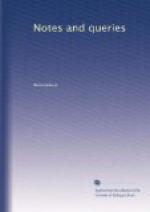NOTES
Portrait of Cardinal Beaton.
A portrait of this eminent Man was engraved by Pennant, from a picture at Holyrood House, in Part ii. of his Tour in Scotland, p. 243. 4to. Lond. 1776. Lodge has an engraving from the same portrait in his collection of Illustrious Personages. This is a strange circumstance; because, when Pinkerton was about to include this portrait in his collection, Pennant wrote to him, on 30th April, 1796, as follows:
“Give me leave to say, that I suspect the authenticity of my Cardinal Beaton. I fear it is Cardinal Falconer or Falconieri. I think there is a genuine one somewhere in Scotland. It will be worth your while to inquire if there be one, and engrave it, and add my suspicions, which induce you do it.”—Pinkerton’s Correspondence, vol. i. p. 402. 8vo. Lond. 1830.
Pinkerton made inquiry, and on Dec. 1st, 1797, writes to the Earl of Buchan:
“Mr. Pennant informs
me the Cardinal Beaton is false. It is, indeed,
too modern. A real Beaton
is said to exist in Fife.”—Pinkerton’s
Correspondence, vol.
ii. p. 17.
Lord Buchan writes to him that Mr. Beaton, of Balfour, believes himself to have a genuine portrait of the Cardinal, and offers it for engraving. The authenticity of this portrait, however, appears not to have been established, and it was not engraved. Another was found at Yester, and was at first concluded to be a genuine original: but Lady Ancram soon discovered that it possessed no marks of originality, but might be a good copy: it was, however, certainly not one of the six cardinals purchased by the third Earl of Lothian. Finally, it was rejected altogether. A copy of a portrait from the Vatican was also rejected as undoubtedly spurious. It appears, therefore, that Pinkerton, in this case at least, exercised caution in the selection of his subject for engraving, so far as concerned authenticity. His criticism, that the Holyrood House portrait is “too modern,” will be agreed in by all who will take the trouble to compare the portrait in Lodge with undoubted portraits of the time: the style is too modern by a hundred years. But the portrait is of a man upwards of sixty years old: Beaton was murdered in 1546, in the fiftieth year of his age. The portrait is of a dark haired man without beard.
I now come to a portrait of Beaton which there appears reason to think is genuine, and I beg the favour of your correspondents to give me any information in their power regarding it. This portrait is in the Roman Catholic College at Blairs, near Aberdeen. It was in the Scotch College at Rome down to the period of the French occupation of that city in 1798, and formed part of the plunder {434} from that college. It was subsequently discovered in a sale-room by the late Abbe Macpherson, rector of the same college,




